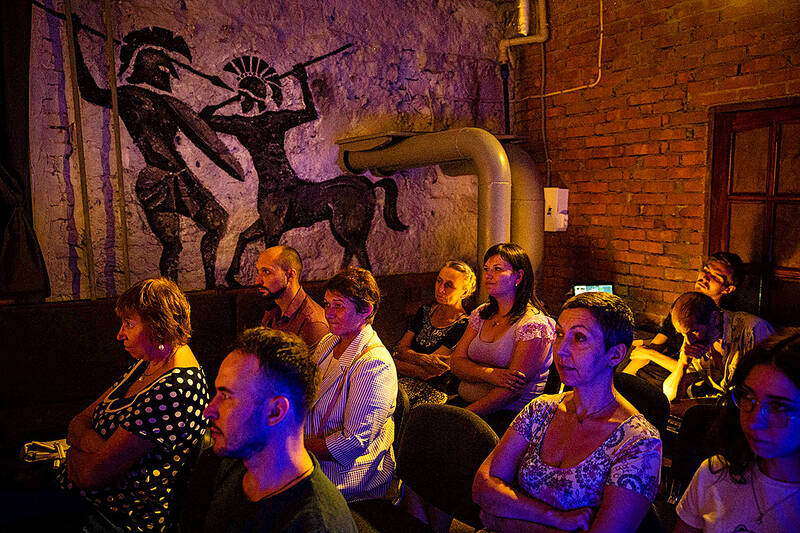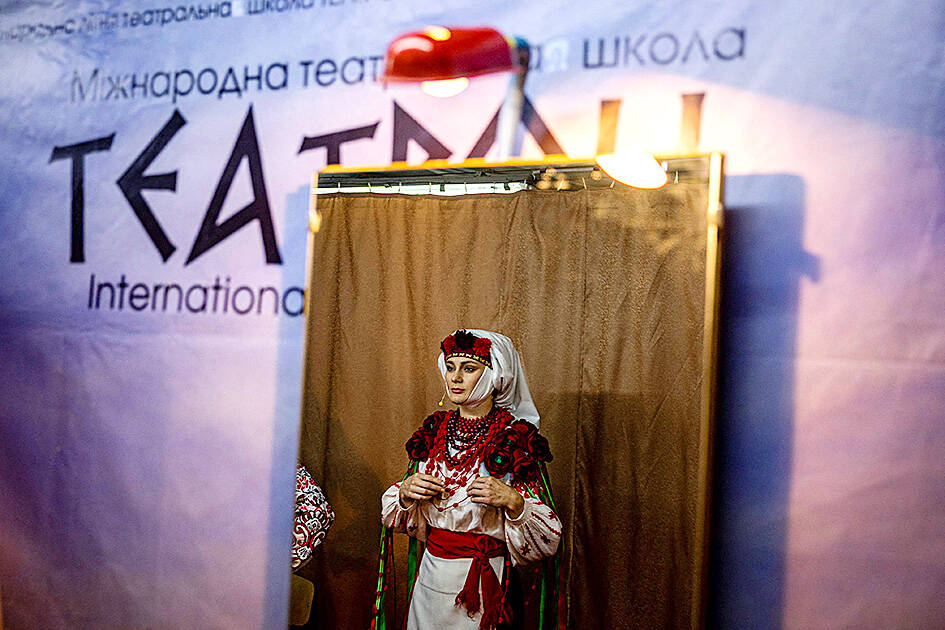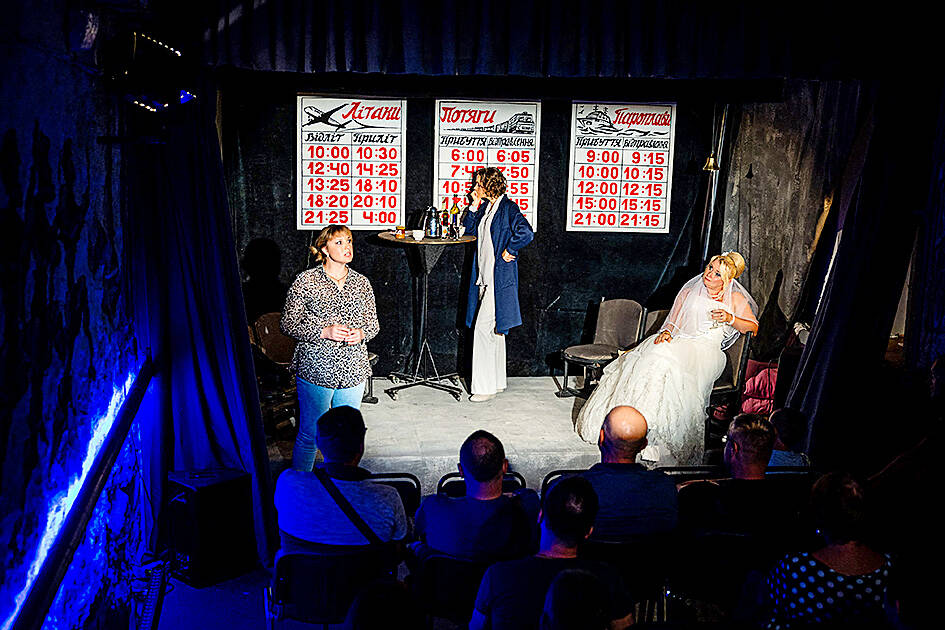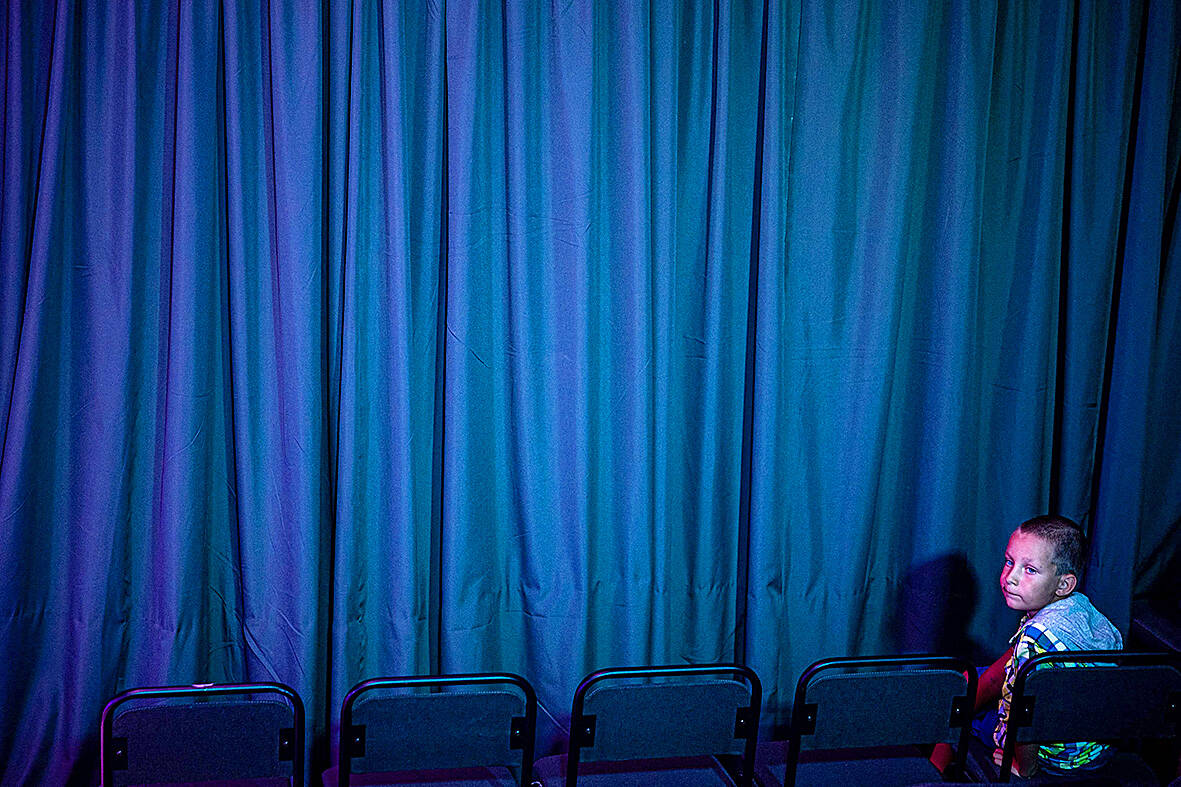It’s an opening night like no other at Mykolaiv’s theater, with the audience ushered down into an underground shelter this week for the first performance since war broke out.
“We need this place to fight on the cultural front too,” artistic director Artiom Svytsoun says.
The tiny underground stage and the minimalist set provides “a form of ‘art therapy’” for the people who have stayed in Mykolaiv and need something other than the grinding fear of war.

Photo: AFP
Welcoming audience members, giving tours of the subterranean theater and taking care of the myriad technical details, 41-year-old Svytsoun is the beating heart of the operation. He is the one who worked to get the theater reopened in the relative safety of an underground bunker.
With the help of a European aid fund, his team took two months to transform a shelter four meters below ground into the 35-seat venue, its irregular white walls covered with a fresco reminiscent of classical theaters.
The strategic port city of Mykolaiv had a population of half a million souls before Russia invaded on Feb. 24.

Photo: AFP
Now it bears the scars of the many bombardments it has endured almost daily for the past six months. Three hundred meters from the elegant neo-classical building that houses the theater stands the twisted concrete shell of the regional administration, which was hit by a missile on March 29 that killed 37 people.
NAME CHANGE
According to the local town hall, the city has enjoyed just 25 attack-free days since Feb. 24. President Volodymyr Zelensky has said that, along with Kharkiv in the north and the eastern Donbas region, Mykolaiv is the most heavily bombed city in Ukraine, despite the fact that the front line is about 20km away.

Photo: AFP
The destruction has not been limited to military targets. Three universities were recently bombed and, according to regional authorities, 123 cultural institutions have been destroyed in the region since the fighting began.
Another effect of the invasion on the Mykolaiv theatre has been a name change.
The former Mykolaiv Russian Drama Theatre is now the Mykolaiv Theatre of Dramatic Arts.

Photo: AFP
In the tiny dressing room, its walls covered with photos of Soviet, Ukrainian and Hollywood actors, Kateryna Chernolishenko, 43, receives the final touches to her stage make-up and is in a good mood.
“I’m very happy to be back on our stage, back home, and I think it’s important that art can be a support for people,” says the actress, who like her fellow thespians volunteered to take part in this premiere.
Her colleague Marina Vassyleva, who is about to don a wedding dress, adds emphatically: “Actors, in these circumstances, are the doctors of the human soul.”

Photo: AFP
“I see my mission and the meaning of my life right now. I am needed here in Mykolaiv,” she says.
MAKING LIVES EASIER
Since the start of the war, three of the theater’s actors have joined the army and another 20 percent of the troupe have taken refuge elsewhere in Ukraine, or abroad — a modest proportion in a town that has lost more than half its population, according to the town hall.
The company is used to playing in a 450-seater theater.
Now the plays are being adapted and squeezed into the “stage in the shelter,” as it is called. But despite the war, it is not just about performing patriotic works. After a curtain-raiser paying tribute to Ukraine, the first play of the new season, by a contemporary national author, is an absurdist play about “the realization of our desires”, says Svytsoun.
The bunker theater will put on two shows a day, from Thursday to Sunday, much to the delight of theatergoer Olga Kroutchok. “I hope to come back every weekend. Theater brings emotions to people in these times of war, and it makes our lives easier,” said the 55-year-old.
Fellow audience member Oleksander Skotnikov, 42, agrees. “When we are under the bombs, as we are now, the theater gives us a big smile and inspires people to keep on living.”

June 23 to June 29 After capturing the walled city of Hsinchu on June 22, 1895, the Japanese hoped to quickly push south and seize control of Taiwan’s entire west coast — but their advance was stalled for more than a month. Not only did local Hakka fighters continue to cause them headaches, resistance forces even attempted to retake the city three times. “We had planned to occupy Anping (Tainan) and Takao (Kaohsiung) as soon as possible, but ever since we took Hsinchu, nearby bandits proclaiming to be ‘righteous people’ (義民) have been destroying train tracks and electrical cables, and gathering in villages

Dr. Y. Tony Yang, Associate Dean of Health Policy and Population Science at George Washington University, argued last week in a piece for the Taipei Times about former president Ma Ying-jeou (馬英九) leading a student delegation to the People’s Republic of China (PRC) that, “The real question is not whether Ma’s visit helps or hurts Taiwan — it is why Taiwan lacks a sophisticated, multi-track approach to one of the most complex geopolitical relationships in the world” (“Ma’s Visit, DPP’s Blind Spot,” June 18, page 8). Yang contends that the Democratic Progressive Party (DPP) has a blind spot: “By treating any

This year will go down in the history books. Taiwan faces enormous turmoil and uncertainty in the coming months. Which political parties are in a good position to handle big changes? All of the main parties are beset with challenges. Taking stock, this column examined the Taiwan People’s Party (TPP) (“Huang Kuo-chang’s choking the life out of the TPP,” May 28, page 12), the Democratic Progressive Party (DPP) (“Challenges amid choppy waters for the DPP,” June 14, page 12) and the Chinese Nationalist Party (KMT) (“KMT struggles to seize opportunities as ‘interesting times’ loom,” June 20, page 11). Times like these can

Swooping low over the banks of a Nile River tributary, an aid flight run by retired American military officers released a stream of food-stuffed sacks over a town emptied by fighting in South Sudan, a country wracked by conflict. Last week’s air drop was the latest in a controversial development — private contracting firms led by former US intelligence officers and military veterans delivering aid to some of the world’s deadliest conflict zones, in operations organized with governments that are combatants in the conflicts. The moves are roiling the global aid community, which warns of a more militarized, politicized and profit-seeking trend